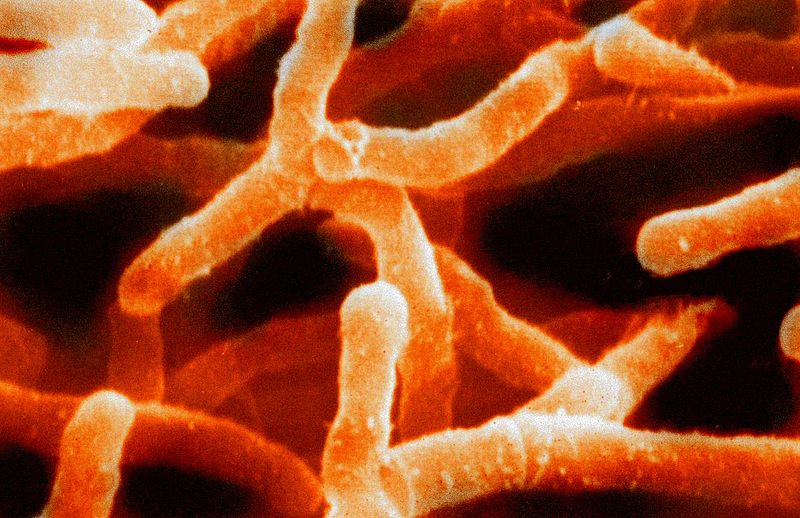Actinomyces
| Actinomyces | ||||||||||||
|---|---|---|---|---|---|---|---|---|---|---|---|---|
 Scanning electron micrograph of Actinomyces israelii.
| ||||||||||||
| Scientific classification | ||||||||||||
| ||||||||||||
| Species | ||||||||||||
|
A. bovis |
|
Actinomycosis Microchapters |
|
Diagnosis |
|---|
|
Treatment |
|
Actinomyces On the Web |
|
American Roentgen Ray Society Images of Actinomyces |
Editor-In-Chief: C. Michael Gibson, M.S., M.D. [1]
Overview
Actinomyces (from Greek "actis" ray, beam and "mykes", fungus) is a genus of the actinobacteria class of bacteria. They are all gram-positive. Actinomyces are facultatively anaerobic (except A. meyeri, a strict anaerobe). All species grow best under anaerobic conditions. Actinomyces species may form endospores, and, while individual bacteria are rod-shaped, Actinomyces colonies form fungus-like branched networks of hyphae.[1] The aspect of these colonies initially led to the incorrect assumption that the organism was a fungus and to the name "Actinomyces" or ray fungus.
Actinomyces are known for causing disease in humans, and for the important role they play in soil ecology. They produce a number of enzymes that help degrade organic plant material, lignin, and chitin. As such, their presence is important in the formation of compost. Some species have been found as part of the healthy vaginal microbiota.[2]
Genomics
Phylogenetic trees based on 16S rRNA sequences have shown that the genus Actinomyces is quite diverse, exhibiting polyphyletic branching into several clusters. The genera Actinomyces and Mobiluncus form a monophyletic clade in a phylogenetic tree constructed using RpoB, RpoC and DNA Gyrase B protein sequences. This clade is also strongly supported by a conserved signature indel consisting of a 3 amino acid insertion in isoleucine tRNA synthetase found only in the species of the genera Actinomyces and Mobiluncus.[3]
Pathology
Actinomyces species are normally present in the gums and are the most common cause of infection in dental procedures and oral abscesses. Many Actinomyces species are opportunistic pathogens of humans and other mammals, particularly in the oral cavity.[4] In rare cases, these bacteria can cause actinomycosis, a disease characterized by the formation of abscesses in the mouth, lungs, or the gastrointestinal tract.[5] Actinomycosis is most frequently caused by Actinomyces israelii. A. israelii may also cause endocarditis, though the resulting symptoms may be similar to those resulting from infections by other bacterial species.[6][7] Aggregatibacter actinomycetemcomitans has been identified as being of note in periodontal disease.
The genus is typically the cause oral-cervicofacial disease. It is characterized by a painless "lumpy jaw". Lymphadenopathy is uncommon in this form of the disease. Another form of actinomycosis is thoracic disease, which is often misdiagnosed as a neoplasm, as it forms a mass that extends to the chest wall. It arises from aspiration of organisms from the oropharynx. Symptoms include chest pain, fever, and weight loss. Abdominal disease is another manifestation of actinomycosis. This can lead to a sinus tract that drains to the abdominal wall or the perianal area. Symptoms include fever, abdominal pain, and weight loss.[8] Actinomyces species have also been shown to infect the central nervous system in a dog "without history or evidence of previous trauma or other organ involvement." [9]
Pelvic actinomycosis is a rare but proven complication of use of intrauterine devices. In extreme cases, pelvic abscesses might develop. Treatment of pelvic actinomycosis associated with intrauterine device involves removal of the device and antibiotic treatment.[10]
Diagnosis
Actinomycosis may be considered when a patient has chronic progression of disease across tissue planes that is mass-like at times, sinus tract development that may heal and recur, and refractory infection after a typical course of antibiotics.[8]
References
- ↑ Holt JG (editor) (1994). Bergey's Manual of Determinative Bacteriology (9th ed.). Williams & Wilkins. ISBN 0-683-00603-7.
- ↑ Petrova, Mariya I.; Lievens, Elke; Malik, Shweta; Imholz, Nicole; Lebeer, Sarah (2015). "Lactobacillus species as biomarkers and agents that can promote various aspects of vaginal health". Frontiers in Physiology. 6. doi:10.3389/fphys.2015.00081. ISSN 1664-042X.
- ↑ Template:Cite doi
- ↑ Madigan M; Martinko J (editors). (2005). Brock Biology of Microorganisms (11th ed.). Prentice Hall. ISBN 0-13-144329-1.
- ↑ Bowden GHW (1996). Actinomycosis in: Baron's Medical Microbiology (Baron S et al., eds.) (4th ed.). Univ of Texas Medical Branch. (via NCBI Bookshelf) ISBN 0-9631172-1-1.
- ↑ Lam, S; Samraj, J; Rahman, S; Hilton, E (April 1993). "Primary actinomycotic endocarditis: case report and review". Clinical infectious diseases : an official publication of the Infectious Diseases Society of America. 16 (4): 481–5. doi:10.1093/clind/16.4.481. PMID 8513051.
- ↑ Adalja, AA; Vergis, EN (August 2010). "Actinomyces israelii endocarditis misidentified as "Diptheroids"". Anaerobe. 16 (4): 472–3. doi:10.1016/j.anaerobe.2010.05.003. PMID 20493959.
- ↑ Jump up to: 8.0 8.1 El Sahli, MD, MS. "Anaerobic Pathogens." Infectious Disease Module 2007. Baylor College of Medicine, 2007.
- ↑ Couto, SS; Dickinson, PJ; Jang, S; Munson, L (November 2000). "Pyogranulomatous meningoencephalitis due to Actinomyces sp. in a dog". Veterinary pathology. 37 (6): 650–2. doi:10.1354/vp.37-6-650. PMID 11105955.
- ↑ Joshi C, Sharma R, Mohsin Z. Pelvic actinomycosis: a rare entity presenting as tubo-ovarian abscess. Arch Gynecol Obstet. 2010 Feb;281(2):305-6